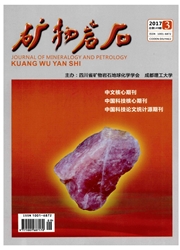

 中文摘要:
中文摘要:
苏北盆地盘石山和方山新生代玄武岩中广泛发育橄榄岩包体,以尖晶石二辉橄榄岩为主,少数为尖晶石方辉橄榄岩。盘石山橄榄岩的岩相学特征表明其经历过Ol+Cpx+Melt=Ol+Opx+Melt的反应过程,而方山橄榄岩的这种反应过程不明显,表明古老的岩石圈地幔物质在方山下部仍有残留。与华北地块东部早古生代地幔橄榄岩相比较,本地区橄榄岩包体中橄榄石的Fo值为0.89~0.90,斜方辉石的En值为0.88~0.90,表现为饱满玄武质组分的特点,表明从早古生代至新生代期间经历了岩石圈的减薄和岩石圈地幔的置换。平衡温压估算结果表明,方山橄榄岩平衡温度为985℃~1081℃,平衡压力为1.65GPa~2.61GPa,对应的深度为53km~84km;盘石山橄榄岩平衡温度为940℃~1010℃,平衡压力为0.90GPa~2.07GPa,对应的深度为29km~66km。盘石山橄榄岩包体的起源深度小于方山,苏北盆地新生代时期岩石圈地幔的厚度约为50km,位于岩石圈30km~80km之间。
 英文摘要:
英文摘要:
Peridotitic xenoliths in the Cenozoic basalts from Panshishan and Fangshan in Subei basin are mainly spinel lherzolite with minor spinel harzburgite. Petrographic observation for the peridotitic xenoliths from Panshishan shows that they might undergo a reaction process of Ol+ Cpx+Melt= Ol+Opx+ Melt. However, petrographic observation for the peridotitic xenoliths from Fangshan does not show this kind of reaction process,indicating that there was still residue of the old lithospheric mantle material beneath this area. Comparing with the Early Paleozoic mantle peridotite from the North China Block,the peridotitic xenoliths in Subei basin are more fertile in basaltic components with the Fo values of olivines being from 0.89 to 0.90 and the En values of orthopyroxenes being from 0.88 to 0. 90 , indicating that the lithospheric thinning and the lithospheric mantle replacement took place from Early Paleozoic to Cenozoic. The estimated equilibrium temperature of peridotites from Panshishan and Fangshan ranges from 940℃ to 1 010℃ and 985 ℃ to 1 081 ℃ ,respectively. The estimated equilibrium pressure for that of Panshishan and Fangshan ranges from 0.90 GPa to 2.07 GPa and from 1.65 GPa to 2.61 GPa, corresponding to depth of 29 km to 66 km and 53 km to 84 km,respectively. Therefore,the derived depth of xenolith from Panshishan was less than that of Fangshan. The thickness of lithospheric mantle underneath Subei basin during Cenozoic was about 50 km,between 30 km and 80 km depths in the lithospheric profile.
 同期刊论文项目
同期刊论文项目
 同项目期刊论文
同项目期刊论文
 期刊信息
期刊信息
